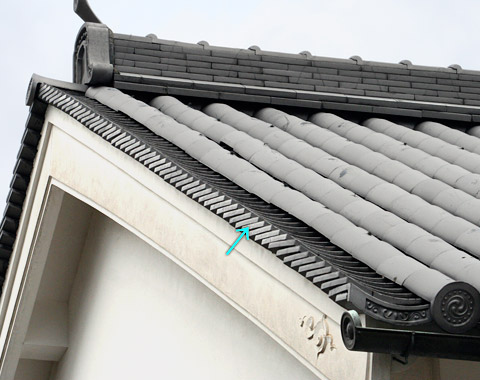|
||
 |
||

(C)2001 Japanese Architecture and Art Net Users System. No reproduction or republication without written permission.
掲載のテキスト・写真・イラストなど、全てのコンテンツの無断複製・転載を禁じます。
|
||||||
| hirasodegawara 平袖瓦 | ||||||
| KEY WORD : architecture / roofing tiles | ||||||
| Also sekigai sodegawara 積蓋袖瓦. A broad,
rectangular type of concave roof tile *hiragawara
平瓦. It is laid from the eave-ends *nokisaki
軒先, to the ridge *munagi
棟木, over the gable bargeboards *hafu
破風, to make a neat finish for the barge course *keraba
螻羽, usually on gable roofs *kirizuma
yane 切妻屋根. Because all of these tiles are of the same shape,
they can be used on both sides of the bargeboards. This method is employed
especially on small temples or shrine gates and on some folk dwellings
*minka 民家, and storehouses
*dozou 土蔵. A tile with
a pendant *gatou 瓦当,
attached is used at the corner ends. This is called *hirasode
kakugawara 平袖角瓦 (broad-sleeve angular tiles).
These pendant tiles are used at the edge of the eave to complete the row
of concave tiles and create a neat finish over the bargeboard of a small
gable roof. Example: the recently erected rear gate, Uramon 裏門 at Nyoirinji
如意輪寺, in Nara. |
||||||
 |
||||||
| REFERENCES: | ||||||
| *nokihiragawara 軒平瓦 | ||||||
| EXTERNAL LINKS: | ||||||
| NOTES: | ||||||
(C)2001 Japanese Architecture and Art Net Users System. No reproduction or republication without written permission. 掲載のテキスト・写真・イラストなど、全てのコンテンツの無断複製・転載を禁じます。 |
||||||